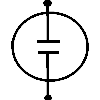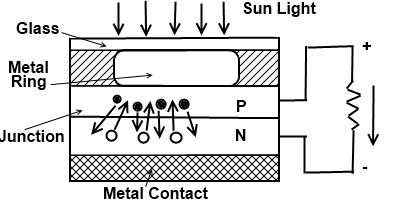Solar Cell
It is a device which converts the light energy into electrical energy. When light is allowed to fall on this cell, the cell generates a voltage across its terminals. This voltage increase whit increase in the light intensity. The cell is so designed that a large area is exposed to light which enhances the voltage generation across the two terminals of the cell. Construction and working is explained below.
Construction and working of Solar Cell
It essentially consists of a silicon PN junction diode with a glass window on top surface layer of P material is made extremely thin so, that incident light photon’s may easily reach the PN junction. When these photons collide with valence electrons’. They comport them sufficient energy as to leave their parent atoms. In this way free electrons and holes are generated on both sides of the junction. Due to these holes and electrons current are produces. This current is directly proportional to the illumination’s (mw/cm2) and also depends on the size of the surface area being illuminated.
The open circuit voltage is a function of illumination. The symbol is shown below.


As shown in the given diagram the Solar cell is like an ordinary diode. It consist of silicon, germanium PN junction with a glass windows on the top surface layer of P-Type, the P-Type material is made very thin and wide so that the incident light photon may easily reach to PN junction.
The P nickel plated ring around the P layer acts as the positive output terminal’s (anode) and the metal contact at the bottom acts as a Cathode.
Silicon and germanium are the most widely used semiconductors materials for solar cells although gallium arsenide, Indium arsenide and Cadmium arsenide are also being used nowadays.
